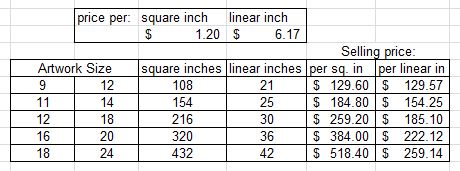

3 ways to price your artwork
One of the perennial questions that artist ask is “How do I price my artwork?” A quick Google search gives all kinds of suggestions. You want to keep in mind that your buyers need to be able to understand why a piece is priced the way it is. It helps to have a standard pricing method, so you can explain clearly to potential buyers why a piece costs what is does. In addition, having a standardized pricing scheme helps take the emotion out of pricing your work, preventing you from pricing some pieces higher than others based purely on how you feel about the piece. This type of pricing is very difficult to justify to your buyers—they don’t care that a certain piece reminds you of your childhood friend or a favorite vacation spot.

Here, I will present three methods that can be used to price your work for sale. And remember, you can always adapt any pricing method to fit your needs.
1. Materials and time
This is one of the standard methods of pricing artwork. First, you add up the cost of all the materials you used to create a piece of artwork. Then you take whatever hourly wage you assign to yourself and multiply that by the time it took to create the piece. It’s a reasonably straightforward method of pricing and works well for pieces that have a significant materials cost and is probably one of the better methods for pricing three-dimensional work. However, I find this method lacking for artwork like my torn paper collages, which have a minimal materials cost.
2. Square inches
This is another very common pricing method. You multiply the length by the width of your piece to get the size in square inches. You then multiply the number of square inches by a set cost per square inch to get the selling price. One of the potential drawbacks is that as the size of the piece increases, the selling price increases very rapidly. It can be difficult to justify to buyers why a piece that’s only a little larger than another one costs so much more. While it works best for two-dimensional pieces, it can also be modified for use with three-dimensional work by adding in the height of the piece and using cubic inches (length x width x height).
3. Linear inches
This is a modification of the previous method which attempts to minimize the increase in price with size that occurs using the square inch method. Like the square inch method, you take the length and width of your piece but then you add them together instead of multiply to get the size in linear inches. You then multiply by your set price per linear inch to get your selling price. Note that you will probably want to use a higher price per linear inch than your price per square inch to keep the overall price of the piece reasonable. This is the method I currently use when pricing most of my own artwork for sale.
In the example below, you can see a comparison of the last two pricing methods. Notice how the price increases much more rapidly for the square inch pricing than for the linear inch pricing. This is not necessarily a bad thing—in the end it’s Your artwork and you should price it in a way that you are comfortable with.

The thing everyone seems to agree on when pricing your artwork is to not undervalue yourself! Don’t fall into the mindset of pricing based on what you would be willing to pay—you want to price according to what others are willing to pay. Your work has value and if you want people to respect it, it needs to be priced accordingly. It’s difficult at first, especially if you’ve never sold your work before so you have nothing to go on as a starting price. Try researching what other artists are charging for similar work and start there. But always make sure that it is priced in a way that feels fair to you. Make sure you selling price covers the cost of your materials and that you are ‘paying’ yourself a reasonable wage. You want to come away feeling happy once you’ve sold your piece, not feel like you’ve been cheated because the selling price was too low.
How do you go about pricing your work? Do you use one of these methods or something different?